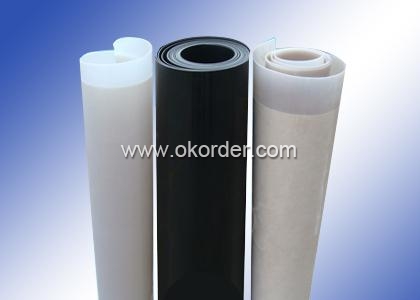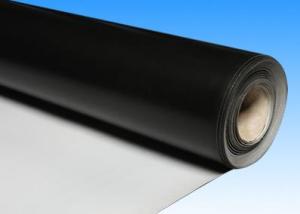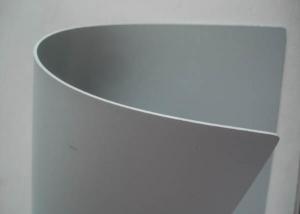High Quality Reinforced PVC Waterproof Membrane Forms
- Loading Port:
- Qingdao Port
- Payment Terms:
- TT or LC
- Min Order Qty:
- 1*20GP m²
- Supply Capability:
- 20 Containers Per Month m²/month
OKorder Service Pledge
OKorder Financial Service
You Might Also Like
Specification Of High Quality Reinforced PVC Waterproof Membrane From China
Width: 2m
Thickness: 1.2mm , 1.5mm , 2.0mm
Length: 20m
Application Of High Quality Reinforced PVC Waterproof Membrane From China
Reinforced PVC waterproof membrane forms an effective barrier to liquid water or water vapor in the roof construction for industrial and civil engineering, underground engineering such as subway & tunnel, water conservancy such as water pools & ditch, shelter, grain depot, land filling, dyke, sewage treatment and basement.
Install Of High Quality Reinforced PVC Waterproof Membrane From China
Hot air welding equipment to weld all overlapping joints on site, forming a seam stronger than the membrane itself
Pictures Of High Quality Reinforced PVC Waterproof Membrane From China


- Q:Can a waterproofing membrane be used on precast concrete block surfaces?
- Yes, a waterproofing membrane can be used on precast concrete block surfaces. Waterproofing membranes are commonly used to protect below-grade structures, such as basements and foundations, from water intrusion. Precast concrete blocks are commonly used in the construction of these structures, and applying a waterproofing membrane can help prevent water from penetrating through the concrete and causing damage. The membrane acts as a barrier, preventing the passage of water while still allowing the concrete to breathe and release any moisture buildup. Additionally, waterproofing membranes can also help improve the overall durability and longevity of the precast concrete blocks by protecting them from moisture-related issues such as cracking, spalling, and corrosion. It is important to choose a waterproofing membrane that is specifically designed for below-grade applications and is compatible with concrete surfaces to ensure proper adhesion and long-term effectiveness.
- Q:Are waterproofing membranes resistant to high temperatures?
- Yes, waterproofing membranes are typically designed to be resistant to high temperatures. They are made from materials such as modified bitumen, PVC, or EPDM that have excellent heat resistance properties, allowing them to withstand high temperatures without degrading or losing their waterproofing capabilities.
- Q:Are waterproofing membranes suitable for historical buildings?
- Waterproofing membranes can be suitable for historical buildings under certain circumstances. These membranes are designed to protect structures from water damage, which can be particularly important for historical buildings that may have aged and porous materials. However, the suitability of waterproofing membranes for historical buildings depends on various factors. Firstly, it is crucial to consider the specific needs and requirements of the historical building in question. Each building has unique characteristics and materials, and the impact of waterproofing on these elements must be carefully evaluated. Some older structures may have delicate architectural features or materials that could be negatively affected by the application of waterproofing membranes. In such cases, alternative methods that are less intrusive or damaging may be more appropriate. Secondly, it is important to consult with conservation experts or professionals who specialize in historical building preservation. These experts can assess the specific needs of the building and provide guidance on the most suitable waterproofing methods. They can also ensure that any interventions are carried out in a manner that respects the historical integrity and authenticity of the structure. Lastly, it is crucial to consider the long-term implications of waterproofing membranes on historical buildings. While they can provide effective protection against water damage, they may also alter the natural breathability of the building, potentially leading to moisture buildup and further deterioration. Therefore, it is essential to carefully balance the benefits of waterproofing with the potential risks and long-term consequences. In summary, waterproofing membranes can be suitable for historical buildings, but their application should be approached with caution. An assessment of the building's specific needs, consultation with preservation experts, and consideration of long-term implications are critical in determining the appropriateness of waterproofing membranes for historical structures.
- Q:Can a waterproofing membrane be used in areas with extreme weather conditions, such as hurricanes or snowstorms?
- Yes, a waterproofing membrane can be used in areas with extreme weather conditions, such as hurricanes or snowstorms. Waterproofing membranes are designed to provide a protective barrier against water infiltration and can effectively withstand various weather conditions. They are made from materials that are resistant to moisture and can be installed in different areas like roofs, basements, or foundations. In regions prone to hurricanes, waterproofing membranes can help prevent water damage by creating a barrier that keeps water out even during heavy rainfall or storm surges. These membranes are often reinforced and have high tensile strength to withstand the strong winds and pressure associated with hurricanes. Similarly, in areas with heavy snowstorms, waterproofing membranes can help prevent water intrusion caused by melting snow or ice dams. They are designed to be flexible and resistant to extreme temperatures, ensuring that they maintain their integrity and prevent leaks even in freezing conditions. However, it is important to choose the right type of waterproofing membrane suitable for the specific weather conditions in the area. Different membranes have varying levels of resistance to extreme weather, so it is advisable to consult with a professional to determine the most appropriate membrane for the specific climate and weather patterns. Additionally, proper installation and regular maintenance are crucial to ensure the longevity and effectiveness of the waterproofing system in extreme weather conditions.
- Q:Are there any specific considerations for installing a waterproofing membrane on precast concrete surfaces?
- Yes, there are specific considerations for installing a waterproofing membrane on precast concrete surfaces. Firstly, the surface must be thoroughly cleaned and free from any dirt, debris, or loose particles. It is also important to ensure that the precast concrete surface is dry before applying the membrane. Additionally, the type of waterproofing membrane used should be compatible with the precast concrete material to ensure proper adhesion. Proper surface preparation, material compatibility, and ensuring a dry surface are key factors to consider when installing a waterproofing membrane on precast concrete surfaces.
- Q:Are waterproofing membranes suitable for indoor applications?
- Yes, waterproofing membranes are suitable for indoor applications. Waterproofing membranes are designed to prevent water penetration and moisture buildup, making them an ideal solution for areas that are prone to water damage, such as basements, bathrooms, and kitchens. These membranes create a barrier that prevents water from seeping through floors, walls, or other surfaces, effectively protecting the structure from water-related issues like mold, rot, and structural damage. Additionally, waterproofing membranes can also help regulate humidity levels, leading to a more comfortable and healthier indoor environment.
- Q:Can a waterproofing membrane be used for potable water tanks?
- No, a waterproofing membrane should not be used for potable water tanks. While a waterproofing membrane is designed to prevent water penetration and protect surfaces from moisture damage, it is not suitable for ensuring the safety and purity of potable water. Potable water tanks require materials that are specifically designed and approved for water storage, such as food-grade coatings or liners. These materials are formulated to prevent any leaching or contamination of the water, ensuring its safety for consumption. Therefore, it is important to use the appropriate materials and follow industry standards and regulations when constructing potable water tanks.
- Q:How does a waterproofing membrane handle joint or crack movements?
- A waterproofing membrane is designed to handle joint or crack movements by being flexible and accommodating the expansion and contraction of the underlying structure. It can stretch and move with the joints or cracks, ensuring that it remains intact and provides a continuous barrier against water penetration.
- Q:Can a waterproofing membrane be used in steam rooms?
- Yes, a waterproofing membrane can be used in steam rooms. A waterproofing membrane is designed to prevent water infiltration and is commonly used in areas where moisture is present, such as bathrooms, showers, and steam rooms. The membrane acts as a barrier, preventing water vapor from penetrating the underlying structure and causing damage. In steam rooms, where high levels of humidity and moisture are present, using a waterproofing membrane is essential to protect the walls, floors, and other surfaces from water damage and mold growth. It is important to choose a waterproofing membrane that is specifically designed for high moisture environments like steam rooms to ensure proper protection and longevity. Additionally, proper installation and adherence to manufacturer guidelines are crucial for the effectiveness and durability of the waterproofing membrane in a steam room setting.
- Q:Are waterproofing membranes suitable for stadium structures?
- Yes, waterproofing membranes are suitable for stadium structures. Stadiums are exposed to various weather conditions such as rain, snow, and humidity, which can potentially damage the structure if proper waterproofing measures are not taken. Waterproofing membranes provide a protective layer that prevents water infiltration, thus safeguarding the stadium from moisture-related issues like leaks, mold, and corrosion. Stadium structures often have large roof areas and expansive seating areas where water can accumulate, making waterproofing crucial. Membranes can be applied on various surfaces, including concrete, metal, and wood, ensuring a versatile and effective waterproofing solution for stadiums. Moreover, waterproofing membranes offer durability and longevity, which is essential for stadiums that are subjected to heavy usage and constant exposure to the elements. They are designed to withstand thermal expansion and contraction, as well as UV radiation, ensuring long-term protection for the structure. Additionally, waterproofing membranes can be customized to meet specific design requirements, allowing architects and engineers to integrate them seamlessly into the stadium's overall aesthetic. These membranes come in various colors, textures, and finishes, enabling them to blend with the surrounding materials and enhance the visual appeal of the stadium. Overall, waterproofing membranes provide a reliable and effective solution for protecting stadium structures from water damage. They offer durability, versatility, and customization options, making them suitable for any stadium construction or renovation project.
1. Manufacturer Overview |
|
|---|---|
| Location | Shandong, China |
| Year Established | 2003 |
| Annual Output Value | Above 50 Million RMB |
| Main Markets | Mid East; Eastern Europe; North America; Southeast Asia |
| Company Certifications | ISO 9001; ISO 14000 |
2. Manufacturer Certificates |
|
|---|---|
| a) Certification Name | |
| Range | |
| Reference | |
| Validity Period | |
3. Manufacturer Capability |
|
|---|---|
| a)Trade Capacity | |
| Nearest Port | Tianjin; Qingdao |
| Export Percentage | 10% |
| No.of Employees in Trade Department | 5-10 People |
| Language Spoken: | English; Chinese |
| b)Factory Information | |
| Factory Size: | Above 2000 square meters |
| No. of Production Lines | Above 5 |
| Contract Manufacturing | OEM Service Offered; Design Service Offered |
| Product Price Range | Negotiated |
Send your message to us
High Quality Reinforced PVC Waterproof Membrane Forms
- Loading Port:
- Qingdao Port
- Payment Terms:
- TT or LC
- Min Order Qty:
- 1*20GP m²
- Supply Capability:
- 20 Containers Per Month m²/month
OKorder Service Pledge
OKorder Financial Service
Similar products
New products
Hot products
Related keywords



























